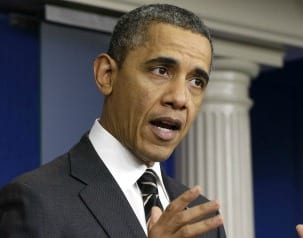Countdown to Sequester: Obama Pushes for Last-Minute Fix
There is no momentum in Congress for passing legislation to stop sequestration – the $85 billion mandatory budget reduction scheduled to take effect March 1 – but that hasn’t stopped President Obama from trying to shame legislators into coming up with another last-second solution for the problem.
Obama, who got Congress to cave in New Year’s Day when the self-manufactured crisis was called the fiscal cliff, is pulling out the stops for a repeat performance this week. Over the weekend, the White House released a state-by-state summary of what programs are going to be affected by sequestration and how much the projected cuts are going to gouge state budgets.
On Monday morning, Obama spoke to the National Governors Association and urged them to get involved in lighting a fire under their representatives in Washington.
“These cuts do not have to happen,” Obama said at the breakfast meeting. “Congress can turn them off with just a little bit of compromise. These cuts will slow our economy, eliminate good jobs and leave a lot of folks who are already pretty thinly stretched scrambling to figure out what to do.”
Taking Sides
The problem for Obama and Congress is that people aren’t sure exactly what side to take on this matter. According to a poll conducted last week by the Pew Research Center, a nonpartisan group that does independent public polling, 70 percent of Americans think it is essential that major legislation be passed to reduce the federal budget deficit … so long as those reductions don’t affect programs they like.
The people interviewed for the survey said they would increase spending on 16 of the 19 programs that were offered up as candidates for being cut.
That included things like Social Security (41 percent for increasing spending, 10 percent for reducing); education (60-10 for increased spending); crime (41-14); roads and infrastructure (38-17) and scientific research (37-22).
Even Defense spending, by far the largest portion of the federal budget, received more support for increased spending (32 percent) than reduced spending (24 percent).
The only programs where there was more support for cutting spending than increasing it were aid to the world’s needy (48 percent for decrease; 21 for increasing); the State Department (34-14 for decreased spending); and aid to the unemployed (32-24 for decreasing).
Cuts and Confusion
The White House seems to be the only one reacting to the confused state of mind demonstrated by voters. The state-by-state summary it released includes an introduction that gives President Obama credit for working with Congress to reduce the deficit by more than $2.5 trillion, though there are no specifics on where that $2.5 trillion has gone.
It also pats the president on the back for putting forward a balanced plan that would avoid the harmful effects of sequestering, while also reducing the deficit by more than $4 trillion, but then bemoans the fact that Republicans won’t meet him halfway by throwing more taxes at the wealthiest Americans.
The summary’s conclusion paints a bleak picture of what awaits Americans if sequestration goes through. Expect things like four-hour waits at peak times to get through airport security in the nation’s busiest airports; furloughs or reduced working hours for border patrol, food inspectors, Federal Aviation Association and FBI agents; and cuts to funding for education, small businesses, research, meals for seniors and child care for low-income families.
Michael Steel, a spokesman for House Speaker John Boehner, had a curt response to the summary: “The White House needs to spend less time explaining to the press how bad the sequester will be and more time actually working to stop it.”
Sources:
- Shear, M. (2013, February 25). Obama Urges Congress to Find compromise on Budget Cuts. The New York Times. Retrieved from http://www.nytimes.com/2013/02/26/us/politics/obama-urges-congress-to-find-compromise-on-cuts.html
- Akabas, S. (n.d.). The Sequester: Mechanics and Impact. Bipartisan Policy Center. Retrieved February 25, 2013, from http://bipartisanpolicy.org/sites/default/files/The%20Sequester-%20Mechanics%20and%20Impact.pdf
- Madison, L. (2013, February 25). Obama to governors: Help me get Congress to act on sequester. CBS News. Retrieved from http://www.cbsnews.com/8301-250_162-57571126/obama-to-governors-help-me-get-congress-to-act-on-sequester/
- You will need Adobe Reader to view the PDF Download Adobe Reader


















